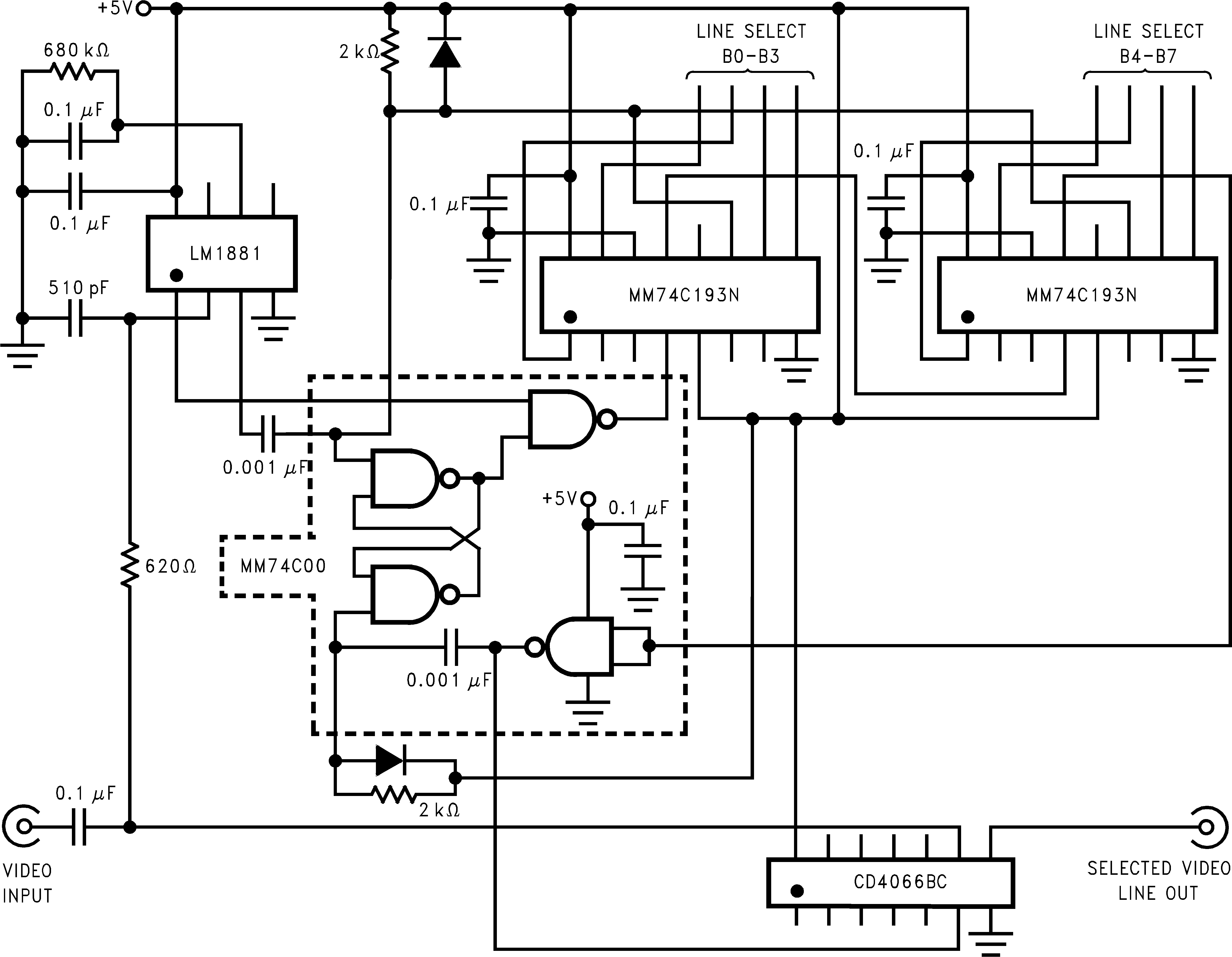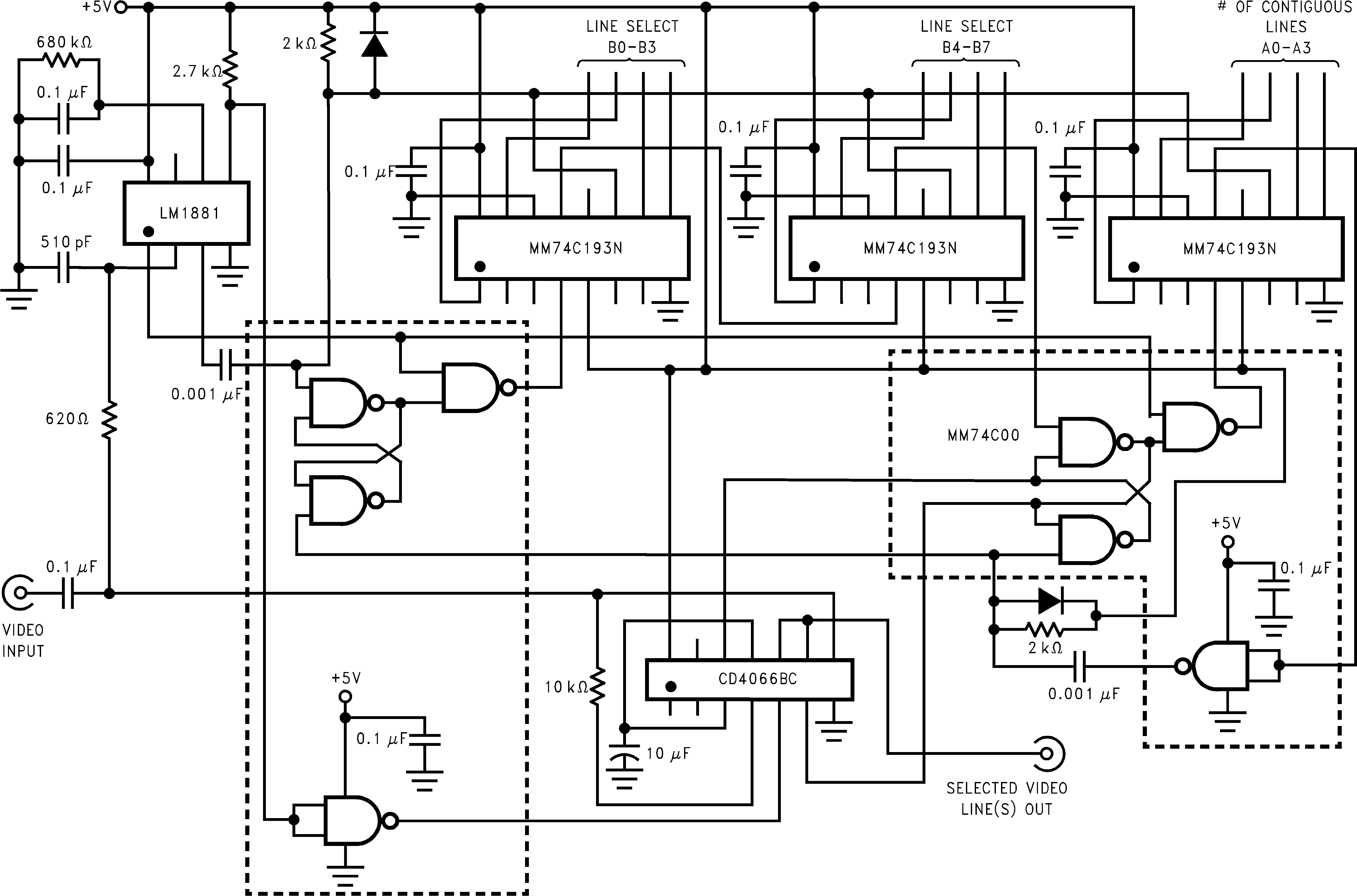SNLS384G February 1995 – June 2015 LM1881
PRODUCTION DATA.
- 1 Features
- 2 Applications
- 3 Description
- 4 Revision History
- 5 Pin Configuration and Functions
- 6 Specifications
- 7 Detailed Description
- 8 Application and Implementation
- 9 Power Supply Recommendations
- 10Device and Documentation Support
- 11Mechanical, Packaging, and Orderable Information
Package Options
Mechanical Data (Package|Pins)
Thermal pad, mechanical data (Package|Pins)
Orderable Information
8 Application and Implementation
NOTE
Information in the following applications sections is not part of the TI component specification, and TI does not warrant its accuracy or completeness. TI’s customers are responsible for determining suitability of components for their purposes. Customers should validate and test their design implementation to confirm system functionality.
8.1 Application Information
Apart from extracting a composite sync signal free of video information, the LM1881 outputs allow a number of interesting applications to be developed. As mentioned above, the burst gate or back porch clamp pulse allows DC restoration of the original video waveform for display or remodulation on an R.F. carrier, and retrieval of the color burst for color synchronization and decoding into R.G.B. components. For frame memory storage applications, the odd and even field lever allows identification of the appropriate field ensuring the correct read or write sequence. The vertical pulse output is particularly useful since it begins at a precise time—the rising edge of the first vertical serration in the sync waveform. This means that individual lines within the vertical blanking period (or anywhere in the active scan line period) can easily be extracted by counting the required number of transitions in the composite sync waveform following the start of the vertical output pulse.
The vertical blanking interval is proving popular as a means to transmit data which will not appear on a normal T.V. receiver screen. Data can be inserted beginning with line 10 (the first horizontal scan line on which the color burst appears) through to line 21. Usually lines 10 through 13 are not used which leaves lines 14 through 21 for inserting signals, which may be different from field to field. In the U.S., line 19 is normally reserved for a vertical interval reference signal (VIRS) and line 21 is reserved for closed caption data for the hearing impaired. The remaining lines are used in a number of ways. Lines 17 and 18 are frequently used during studio processing to add and delete vertical interval test signals (VITS) while lines 14 through 18 and line 20 can be used for Videotex/Teletext data. Several institutions are proposing to transmit financial data on line 17 and cable systems use the available lines in the vertical interval to send decoding data for descrambler terminals.
Because the vertical output pulse from the LM1881 coincides with the leading edge of the first vertical serration, sixteen positive or negative transitions later will be the start of line 14 in either field. At this point simple counters can be used to select the desired line(s) for insertion or deletion of data.
8.2 Typical Applications
8.2.1 Video Line Selector
The circuit in Figure 8 puts out a singe video line according to the binary coded information applied to line select bits b0–b7. A line is selected by adding two to the desired line number, converting to a binary equivalent and applying the result to the line select inputs. The falling edge of the LM1881's vertical pulse is used to load the appropriate number into the counters (MM74C193N) and to set a start count latch using two NAND gates. Composite sync transitions are counted using the borrow out of the desired number of counters. The final borrow out pulse is used to turn on the analog switch (CD4066BC) during the desired line. The falling edge of this signal also resets the start count latch, thereby terminating the counting.
The circuit, as shown, will provide a single line output for each field in an interlaced video system (television) or a single line output in each frame for a non-interlaced video system (computer monitor). When a particular line in only one field of an interlaced video signal is desired, the odd and even field index output must be used instead of the vertical output pulse (invert the field index output to select the odd field). A single counter is needed for selecting lines 3 to 14; two counters are needed for selecting lines 15 to 253; and three counters will work for up to 2046 lines. An output buffer is required to drive low impedance loads.
 Figure 8. Video Line Selector
Figure 8. Video Line Selector
8.2.1.1 Design Requirements
The design must have a single line output in an interlaced video system.
The use case can be used for televisions of computer monitors.
8.2.1.2 Detailed Design Procedure
For the composite input pin, a 510-pF capacitor and 620-Ω resistor are selected to create a lowpass filter for 500 kHz.
For Rset, a 680-kΩ was selected to allow for the Vertical Default Sync Delay Time to be set for 64 uS. Please refer to Figure 2 for Rset value selection.
8.2.2 Multiple Contiguous Video Line Selector With Black Level Restoration
The circuit in Figure 9 will select a number of adjoining lines starting with the line selected as in the previous example. Additional counters can be added as described previously for either higher starting line numbers or an increased number of contiguous output lines. The back porch pulse output of the LM1881 is used to gate the video input's black level through a lowpass filter (10-kΩ, 10-µF) providing black level restoration at the video output when the output selected line(s) is not being gated through.
8.2.2.1 Design Requirements
The design will select a number of adjoining lines starting with the line selected in the previous application example.
8.2.2.2 Detailed Design Procedure
Another MM74C193N counter is added to the design to support the additional line outputs.
A 10-kΩ resistor and 10-uF capacitor is added to the output of the BURST/BLACK Porch pin to create a low pass filter which adds in black level restoration to the video.
For the composite input pin, a 510-pF capacitor and 620-Ω resistor are selected to create a lowpass filter for 500 kHz.
For Rset, a 680-kΩ was selected to allow for the Vertical Default Sync Delay Time to be set for 64 uS. Please refer to Figure 2 for Rset value selection.
